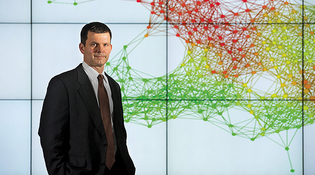 loading
loading
Light & VerityNew engineering dean pulls double dutyDean of science Jeffrey Brock '92 adds engineering to his portfolio.  Courtesy Jeffrey BrockJeffrey Brock ’92, the new dean of the School of Engineering and Applied Science, is a mathematician by discipline. View full imageA year and a half after T. Kyle Vanderlick stepped down as dean of Yale’s School of Engineering and Applied Science (SEAS), the university found her successor right under its nose. In July, Yale announced that Jeffrey Brock ’92, a mathematician who came to Yale from Brown in 2018, would take over the deanship for a three-year term beginning on August 1. Since January 1, Brock has served in the new position of dean of science for the Faculty of Arts and Sciences, a job he will continue in tandem with the SEAS deanship. Brock’s appointment—and his dual portfolio—comes at a time when Yale is figuring out how to expand in five areas of science it articulated in a report last year: integrative data science, quantum science, neuroscience, inflammation, and environmental and evolutionary sciences. (See “Big Ideas,” September/October 2018.) “Engineering touches every single one of those top priorities,” says Faculty of Arts and Sciences dean Tamar Gendler ’87. With one dean overseeing Yale’s nine FAS science departments and SEAS, she says, efforts in those areas can be better coordinated across disciplines. Brock earned his undergraduate degree in math at Yale, but, he says, “I was almost an English major. And I did music, too. I didn’t want to go to a tech school or a conservatory, so Yale was ideal in that way. I fell in love with the intellectual climate.” He plays upright bass and used to perform after-dinner duets in the Saybrook College dining hall with his friend Vijay Iyer ’92, now a professional jazz pianist and composer. (They formed two thirds of the Vijay Iyer Trio when they were in grad school at Berkeley together.) Brock’s well-rounded background dovetails with SEAS’s professed mission to create what it calls “Y-shaped engineers” who approach engineering with “breadth, depth, and purpose.” “Yale’s strength is its breadth as a university, which allows us to engage questions in a deeper way and think about the larger societal impact of things like artificial intelligence,” Brock says. Brock’s work in mathematics has focused on low-dimensional geometry and topology. Although he is not himself an engineer, Brock has taught engineering students and has been involved in engineering-adjacent work. At Brown, he helped create a federally funded institute focusing on data science. How will Brock fill two positions conceived as full-time jobs? As it happens, some of the duties overlap: since SEAS is part of the Faculty of Arts and Sciences, a substantial part of each job is participating in FAS planning and decision-making; Brock will just wear two hats at the meetings. And some of the responsibilities involving tenure and appointments in the FAS science departments have been assigned to a pair of divisional committee chairs in life sciences and physical sciences. In the 18 months since Vanderlick’s return to teaching, the school has been run by interim dean Mitchell Smooke, the Strathcona Professor of Mechanical Engineering and Materials Science and Applied Physics. The interim period coincided with the university’s efforts to map out its future in science and engineering. “Yale has spent most of that time coming up with a campus-wide strategic plan, and we needed the right leader to implement that,” says Gendler. “It was a process of figuring out just who we were looking for—and then discovering he was already here.”
The comment period has expired.
|
|